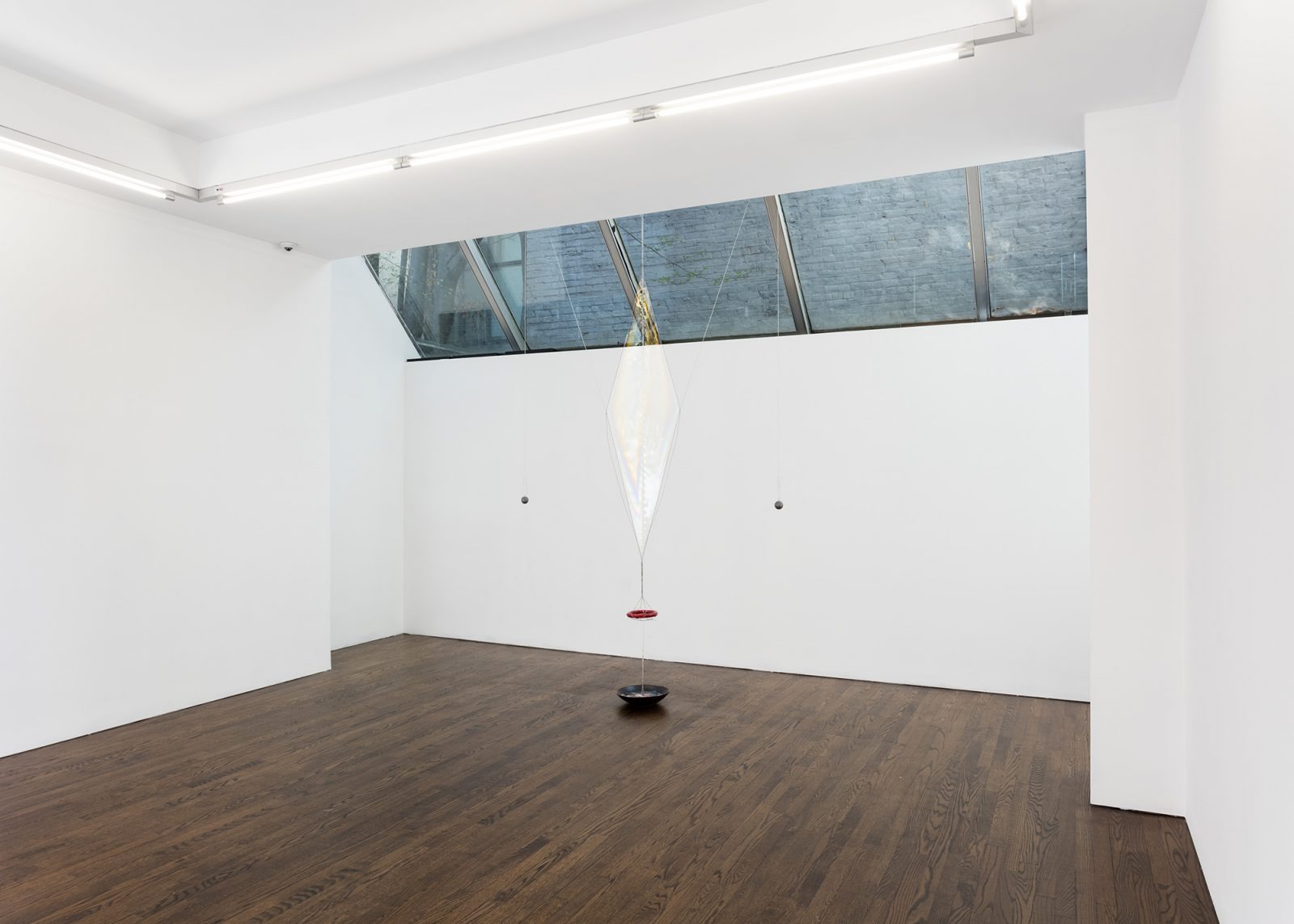Tauba Auerbach
12 Apr - 01 Jun 2019
TAUBA AUERBACH
12 April – 1 June 2019
Tauba Auerbach wants to know how matter and energy flow; how rhythms and patterns emerge from and structure these flows; and how electromagnetic flows in the body and brain amount to life and consciousness. To investigate these things, she pours through scientific journals, attends philosophical conferences, and studies YouTube videos on anatomy, magnetism, and molecular biology. But Auerbach is equally engaged by heterodox theories and indigenous wisdom—panpsychism, traditional medicinal practices, ancient string games—viewing the path of knowledge as a spiral that always doubles back to confirm and revive neglected or rejected perspectives. She approaches all these subjects as an artist, embracing art’s subjectivity and taking bias as a data point in her investigation of the world.
Auerbach’s exploration of fluid dynamics is evident in her Extended Object paintings (2018– ), which freeze a field of cascading droplets that appear to vibrate, swirl, and eddy, though they are motionless. Her Ligature Drawings (2017– ) elaborate on the connections between flow patterns and traditions of ornament, following a pulsing line through improvisational calligraphy. “I don’t want to just draw the rhythm,” she says; “I want to be the rhythm, to sense the rhythms I already am.”
Auerbach’s latest work—her first kinetic sculpture—pushes this idea further. Rather than picturing the rhythms of fluids and forms, the sculpture instantiates these dynamics. As time passes, soap film fills the chamber of an active central mechanism. Made of twisted metal wires and powered by the sun, the sculpture reflectsAuerbach’s fascination with fascia (the meshwork of connective tissue that surrounds muscles, organs, glands, and blood vessels) as well as the BioTensegrity model of anatomy and flow of electrical energy within the human body. Joining this work is a series of infrared photographs documenting heat and a YouTube video library that offers an array of approaches to capturing or modeling the microscopic forms and movements at the heart of Auerbach’s current curiosity.
Biography
For the past fifteen years, Tauba Auerbach has been preoccupied with topology, which she describes as the architecture of connectivity, “within real and theoretical objects, between people socially, between concepts in a philosophy or a system or thought, between the neurons in the brain and between the atoms comprising the chemicals at work within it, between all of space and time determining the shape of the universe in general.” Auerbach has zeroed in on the helix as a structure of particular interest, tracing the helix to collagen, the arrangement of tubalin in microtubules, and to human ornamentation like the Greek Key pattern, using this research as a starting point for imaginative works across a variety of media: weaving, glass, painting, photography, 3D-printing, book making and musical instrument design. In 2013, Auerbach launched Diagonal Press, which makes publications in unsigned, open editions. She is a frequent collaborator with musicians, designers, scientists, and mathematicians.
12 April – 1 June 2019
Tauba Auerbach wants to know how matter and energy flow; how rhythms and patterns emerge from and structure these flows; and how electromagnetic flows in the body and brain amount to life and consciousness. To investigate these things, she pours through scientific journals, attends philosophical conferences, and studies YouTube videos on anatomy, magnetism, and molecular biology. But Auerbach is equally engaged by heterodox theories and indigenous wisdom—panpsychism, traditional medicinal practices, ancient string games—viewing the path of knowledge as a spiral that always doubles back to confirm and revive neglected or rejected perspectives. She approaches all these subjects as an artist, embracing art’s subjectivity and taking bias as a data point in her investigation of the world.
Auerbach’s exploration of fluid dynamics is evident in her Extended Object paintings (2018– ), which freeze a field of cascading droplets that appear to vibrate, swirl, and eddy, though they are motionless. Her Ligature Drawings (2017– ) elaborate on the connections between flow patterns and traditions of ornament, following a pulsing line through improvisational calligraphy. “I don’t want to just draw the rhythm,” she says; “I want to be the rhythm, to sense the rhythms I already am.”
Auerbach’s latest work—her first kinetic sculpture—pushes this idea further. Rather than picturing the rhythms of fluids and forms, the sculpture instantiates these dynamics. As time passes, soap film fills the chamber of an active central mechanism. Made of twisted metal wires and powered by the sun, the sculpture reflectsAuerbach’s fascination with fascia (the meshwork of connective tissue that surrounds muscles, organs, glands, and blood vessels) as well as the BioTensegrity model of anatomy and flow of electrical energy within the human body. Joining this work is a series of infrared photographs documenting heat and a YouTube video library that offers an array of approaches to capturing or modeling the microscopic forms and movements at the heart of Auerbach’s current curiosity.
Biography
For the past fifteen years, Tauba Auerbach has been preoccupied with topology, which she describes as the architecture of connectivity, “within real and theoretical objects, between people socially, between concepts in a philosophy or a system or thought, between the neurons in the brain and between the atoms comprising the chemicals at work within it, between all of space and time determining the shape of the universe in general.” Auerbach has zeroed in on the helix as a structure of particular interest, tracing the helix to collagen, the arrangement of tubalin in microtubules, and to human ornamentation like the Greek Key pattern, using this research as a starting point for imaginative works across a variety of media: weaving, glass, painting, photography, 3D-printing, book making and musical instrument design. In 2013, Auerbach launched Diagonal Press, which makes publications in unsigned, open editions. She is a frequent collaborator with musicians, designers, scientists, and mathematicians.

